Table of Contents
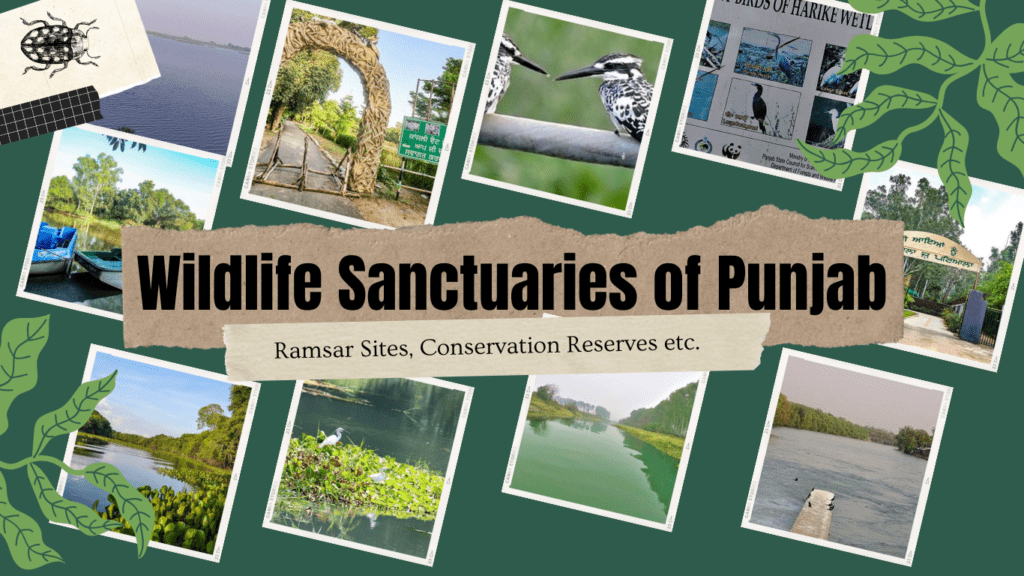
In this article, we are going to learn about the different Wildlife Sanctuaries, Wetlands, Ramsar Sites, Conservation Reserves, Community Reserves, National Parks, and Zoological Parks in Punjab. These are very important and have special significance in Punjab-level competitive exams like the Punjab Public Service Commission (PPSC), Punjab Patwari, Senior Assistant, Excise Inspector, Labour Inspector, and Clerical level exams.
As the name Punjab suggests, it is the “land of five rivers” and has vast forests and protected areas in terms of wetlands, Wildlife Sanctuaries, Ramsar Sites, Conservation Reserves, Zoological Parks, and National Parks, etc. Let’s start with the forest areas of Punjab.
Forests area in Punjab
The geographical location of Punjab is very suitable for vegetation, and four districts of Punjab—Pathankot, Hoshiarpur, Rupnagar, and Nawanshahr—have Shivalik Hills, receive higher rainfall in Punjab, have numerous seasonal streams (Choes), and much of the land in these areas is unsuitable for cultivation because of maximum soil moisture storage capacity in these districts.
The forest area in Punjab is 3084 km², which is about 6.12% of the total geographical area of Punjab, distributed with district-wise forest area intensity:
- Hoshiarpur (34%)
- Rupnagar (24%)
- Nawanshahr (15%)
- Pathankot (10%)
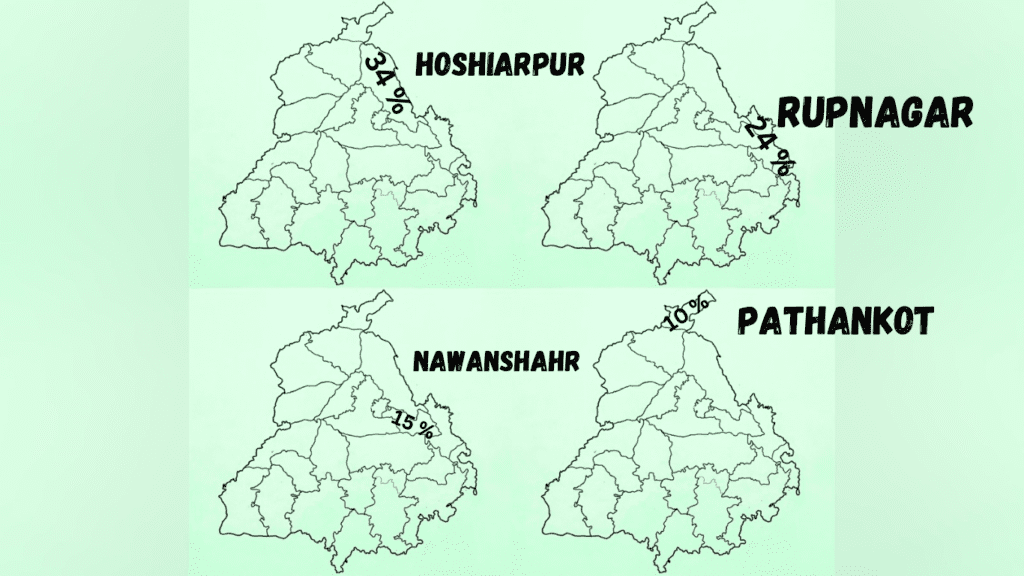
After the northern districts, the central districts—namely Amritsar, Jalandhar, Ludhiana, and Patiala—have low forest cover compared to the districts with Siwalik Hills or Northern districts.
Then, down to the South-Western Punjab districts—mainly Fazilka, Ferozpur, Muktsar Sahib, Mansa, Faridkot, Bathinda, Moga, and Sangrur—have low forest area intensity due to the dune-studded plains, and the intensity is below 2% of the area.
Wildlife Sanctuaries in Punjab
A wildlife sanctuary is a particular area that has entities like ecology, fauna, flora, and has natural or zoological significance. Wildlife sanctuaries are declared for the sole purpose of protecting wildlife in the area, helping propagate and develop its environmental features. In wildlife sanctuaries, there are rules prohibiting the entry of people, but certain rights are granted to some communities or people to live inside the wildlife sanctuaries.
There are the Wildlife Sanctuaries listed in the following table along with the districts where they are situated:
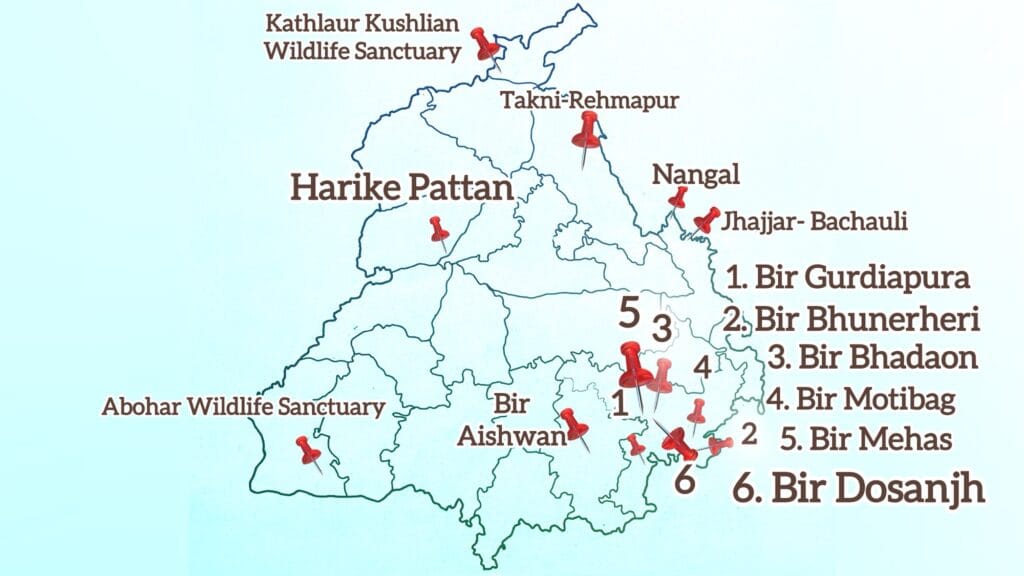
| Wildlife Sanctuaries | Districts |
|---|---|
| Harike-e-Pattan Wildlife Sanctuary | Tarn Taran |
| Takni-Rehmapur Wildlife Sanctuary | Hoshiarpur |
| Abohar Wildlife Sanctuary | Fazilka |
| Bir Motibagh Wildlife Sanctuary | Patiala |
| Bir Gurdialpura Wildlife Sanctuary | Patiala |
| Bir Bhunerheri Wildlife Sanctuary | Patiala |
| Bir Mehas Wildlife Sanctuary | Patiala |
| Bir Dosanjh Wildlife Sanctuary | Patiala |
| Bir Bhadson Wildlife Sanctuary | Patiala |
| Bir Aishwan Wildlife Sanctuary | Sangrur |
| Jhajjar-Bachauli Wildlife Sanctuary | Rupnagar |
| Kathlaur Kushlian Wildlife Sanctuary | Pathankot |
| Nangal Wildlife Sanctuary | Rupnagar |
Important tip: You may have noticed that all Wildlife Sanctuaries located in the Patiala district have names starting with “Bir,” e.g., Bir Gurdialpura Wildlife Sanctuary, Bir Bhunerheri Wildlife Sanctuary, Bir Mehas Wildlife Sanctuary, etc., except Bir Aishwan Wildlife Sanctuary, which is located in the Sangrur district.
Wetland in Punjab
A wetland is an ecosystem encompassing all amenities of nature such as aquatic, semi-aquatic, but in some contexts, it differs based on local and regional differences in soil, topography, climate, water chemistry, vegetation, and other factors.
As per the Ramsar Convention of 1971, the definition of a wetland is: Wetlands are areas of marsh, fen, peatland, or water, whether natural or manmade, permanent or temporary, with water that is static or flowing, fresh, brackish, or salt, but the depth of which at low tide does not exceed 6 meters.
At present, Punjab has 12 natural wetlands and 9 manmade wetlands. The interesting point is that out of these, three have been accorded as Ramsar Sites: Harike Wetland, Kanjli Wetland (the only wetland in the Doaba Region), and Ropar Wetland. Apart from the Ramsar Sites, two others have been accorded as National Wetlands: Ranjit Sagar Wetland and Nangal Wetland.
So, the Punjab wetlands can be classified into the following types according to their importance:
- Ramsar Sites
- Wetland of National Importance
- State wetland
- Other Identified Wetlands
Ramsar sites in Punjab
As stated above, there are 3 Ramsar Sites in Punjab:
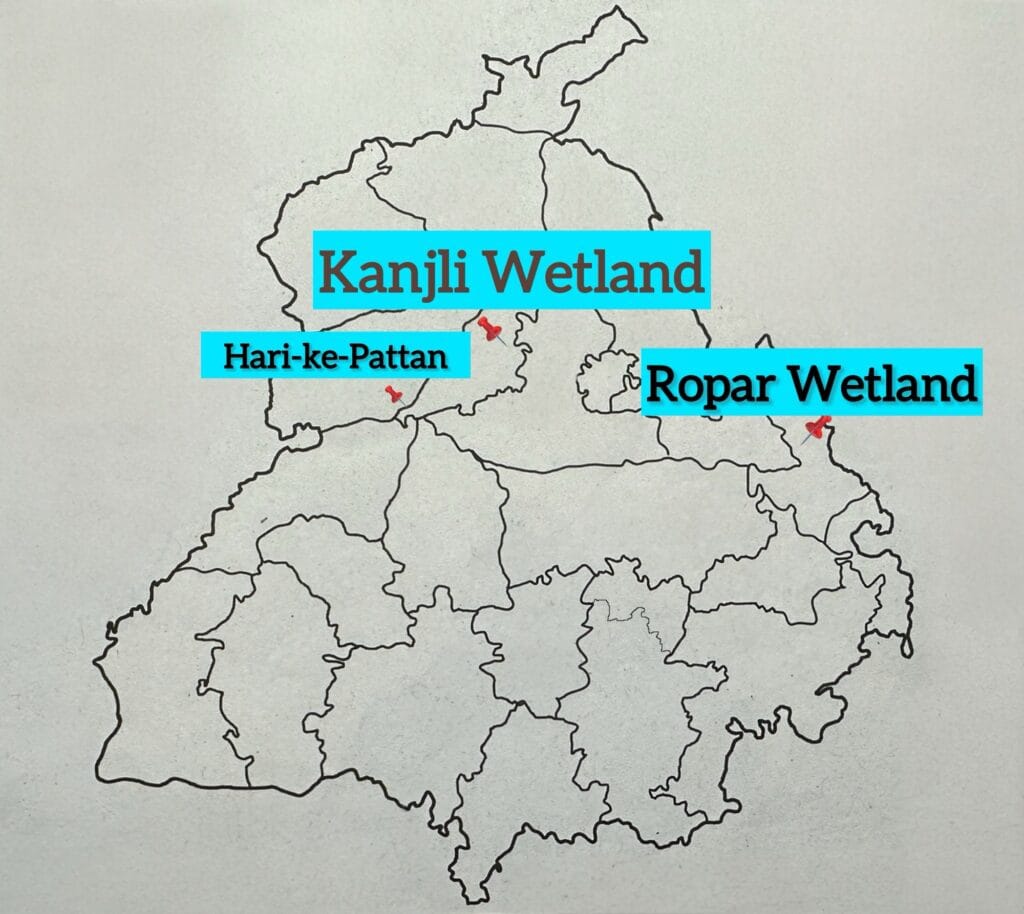
1. Harike Wetland:
Harike Wetland is also known as Hari-ke-Pattan. It is one of the manmade wetlands where the confluence of the Beas and Satluj rivers is present and is one of the largest freshwater wetlands in Northern India, located in the Tarn Taran district. It came into existence in 1952 with the construction of a barrage at the confluence of the Beas and Satluj rivers.
Hari-ke-Pattan is also famous for migratory birds that travel from Siberia to Harike, making it more attractive for tourists and researchers. The Government of Punjab declared Hari-ke-Pattan wetland as a wildlife sanctuary in 1982, and in 1990 it was declared a Ramsar site by the International body of Wetlands under the UNDP.
2. Kanjli Wetland:
It is also a freshwater, manmade wetland and the only wetland present in the Doaba region of Punjab in the Kapurthala District. The Kanjli Wetland was created in 1970 by constructing headworks across the perennial Bein River, a tributary of the Beas River, associated with the first Sikh Guru, Guru Nanak Dev Ji. It was declared a wetland of national importance in 1988 and recognized as a Ramsar site in 2002.
3. Ropar Wetland:
Again, Ropar Wetland is a man-made, freshwater riverine, and lacustrine wetland. Its existence came after the construction of a barrage on the Satluj River, which passes through the Ropar city in 1887. It was declared a wetland of national importance in 1996 and became a Ramsar Site in India in 2002, the same year as the Kanjli Wetland.
Wetlands of National Importance
There are the following 2 National Wetlands in Punjab:
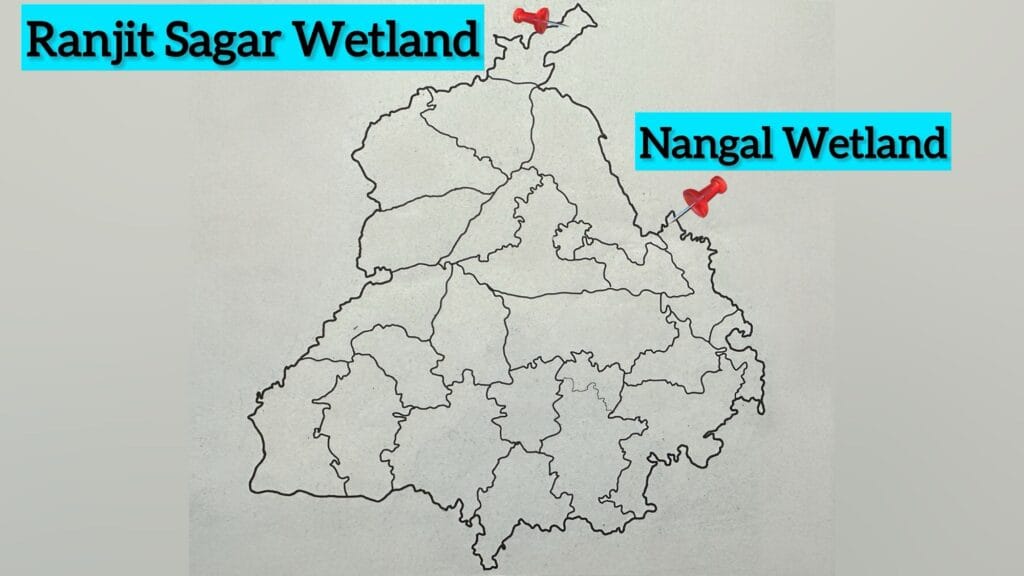
1. Ranjit Sagar Wetland:
Ranjit Sagar Wetland is located on the Ravi River in the Pathankot district upstream of Madhopur headworks. It is also a man-made wetland with fresh body ecology. It was declared a wetland of national importance in 2006.
2. Nangal Wetland:
The Nangal Wetland is located on the Satluj River downstream of the Bhakra Dam and forms a long artificial lake popularly known as Nangal Lake in the Rupnagar district. It was declared a wetland of national importance in 2008 and a wildlife sanctuary in 2009.
State Wetlands:
There are 5 state wetlands in the Punjab:
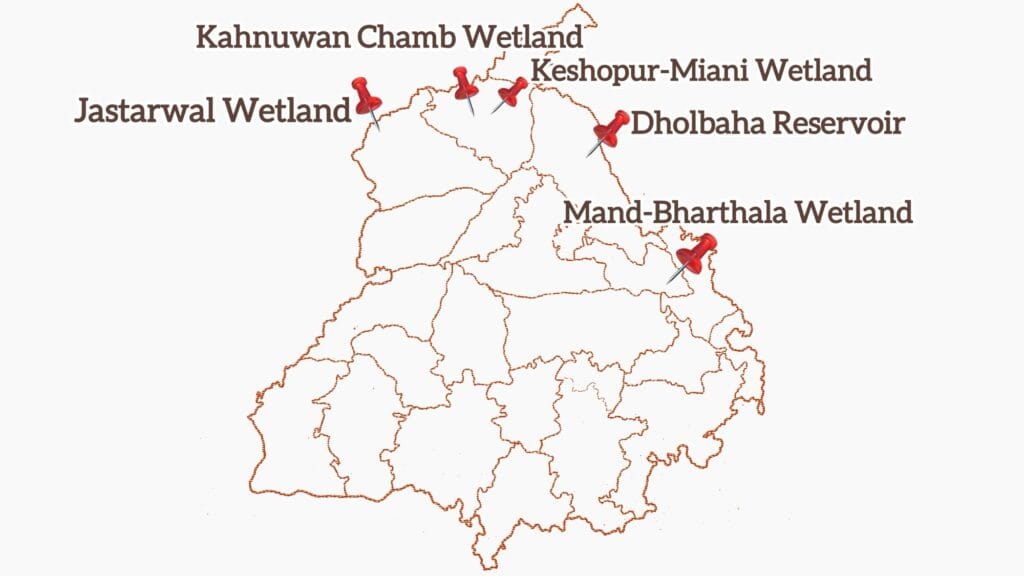
1. Jastarwal Wetland:
It is a natural wetland situated in the Ajnala block of the Amritsar District of Punjab.
2. Kahnuwan Chamb Wetland:
It is also a natural wetland situated in the Gurdaspur district of Punjab.
3. Keshopur-Miani Wetland:
Again, a natural wetland situated in the Gurdaspur district of Punjab.
4. Mand-Bharthala Wetland:
A natural wetland situated in the Nawanshahr (SBS Nagar) district of Punjab.
5. Dholbaha Reservoir:
It is a manmade reservoir situated in the Hoshiarpur district of Punjab.
Other Identified Wetlands:
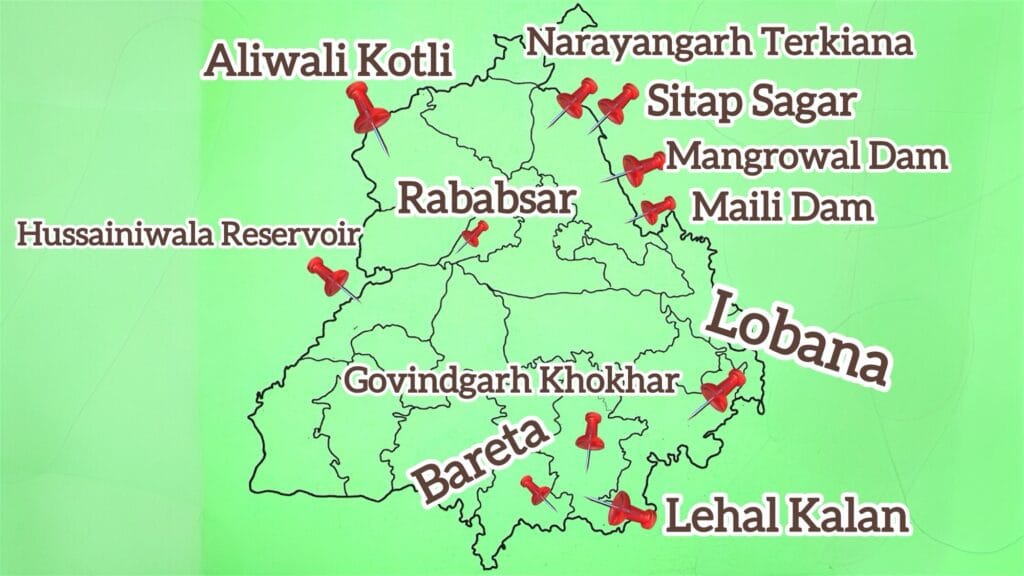
1. Aliwali Kotli:
A natural wetland situated in the Amritsar district of Punjab.
2. Bareta:
A natural wetland situated in the Mansa district of Punjab.
3. Narayangarh Terkiana:
A natural wetland situated in the Hoshiarpur district of Punjab.
4. Sital Sagar:
A natural wetland situated in the Hoshiarpur district of Punjab.
5. Rababsar:
A natural wetland situated in the Kapurthala district of Punjab.
6. Lobana:
A natural wetland situated in the Patiala District of Punjab.
7. Lehal Kalan:
A natural wetland situated in the Sangrur district of Punjab.
8. Gobindgarh Khokhar:
A natural wetland situated in the Sangrur district of Punjab.
9. Hussainiwala Reservoir:
A manmade wetland situated in Ferozpur district of Punjab.
10. Maili Dam:
A manmade wetland situated in the Ferozpur district of Punjab.
11. Mangrowal Dam:
A manmade wetland situated in the Hoshiarpur district of Punjab.
Conservation Reserves in Punjab
Conservation Reserves can be declared by the State Governments in any area owned by the Government, particularly the areas adjacent to National Parks and Sanctuaries and those areas which link one protected area with another. Such declarations should be made after consultations with the local communities. Conservation Reserves are declared for the purpose of protecting landscapes, seascapes, flora, and fauna and their habitats. The rights of people living inside a Conservation Reserve are not affected.
There are 4 Conservation Reserves in Punjab:
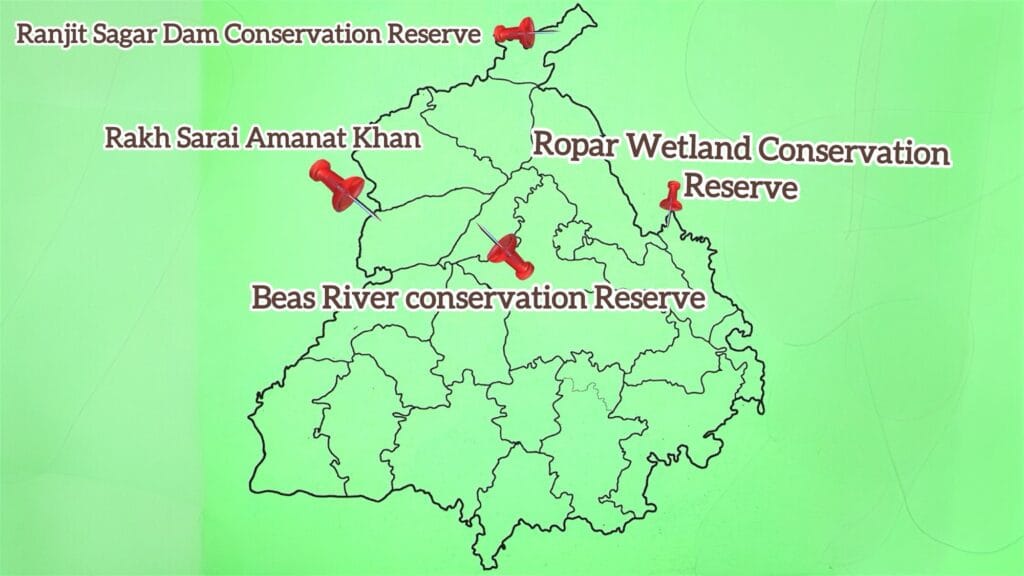
1. Rakh Sarai Amanat Khan Conservation Reserve:
It is situated in the Tarn Taran District of Punjab.
2. Beas River Conservation Reserve:
The area covers the River Beas with all its water channels from 52 Head Talwara to Harike Barrage.
3. Ranjit Sagar Dam Conservation Reserve:
It is situated in the Pathankot District of Punjab.
4. Ropar Wetland Conservation Reserve:
It is situated in the Ropar District of Punjab.
Community Reserves in Punjab
Community Reserves can be declared by the State Government in any area owned by any private person or community, not comprised within a National Park, Sanctuary, or a Conservation Reserve, where an individual or a community has volunteered to conserve wildlife and its habitat. Community Reserves are declared for the purpose of protecting fauna, flora, and traditional or cultural conservation values and practices. As in the case of a Conservation Reserve, the rights of people living inside a Community Reserve are not affected.
The Community Reserves in Punjab were first notified in this country in 2007.
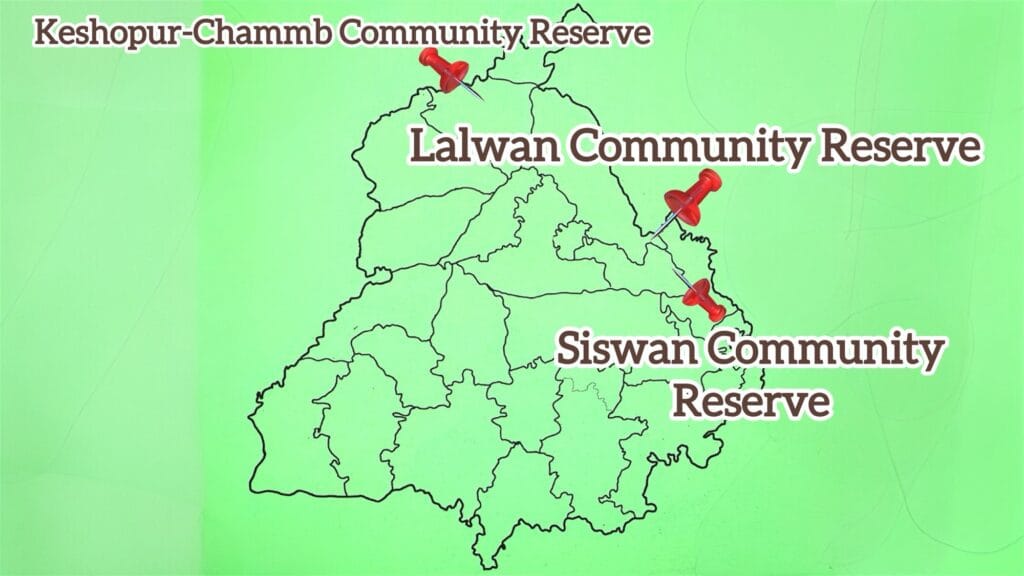
1. Keshopur-Chammb Community Reserve:
It is located in the Gurdaspur district of Punjab.
2. Lalwan Community Reserve:
It is located in the Hoshiarpur District of Punjab.
3. Siswan Community Reserve:
It is located in the S.A.S. Nagar district of Punjab.
National Parks in Punjab
At present, Punjab does not have any designated National Parks within its boundaries. However, the state is home to numerous Wildlife Sanctuaries, Wetlands, Ramsar Sites, Conservation Reserves, and Community Reserves that play a vital role in preserving its rich biodiversity and natural heritage. These protected areas serve as critical habitats for diverse flora and fauna, contributing significantly to ecological balance and environmental sustainability.
Zoological Parks in Punjab:
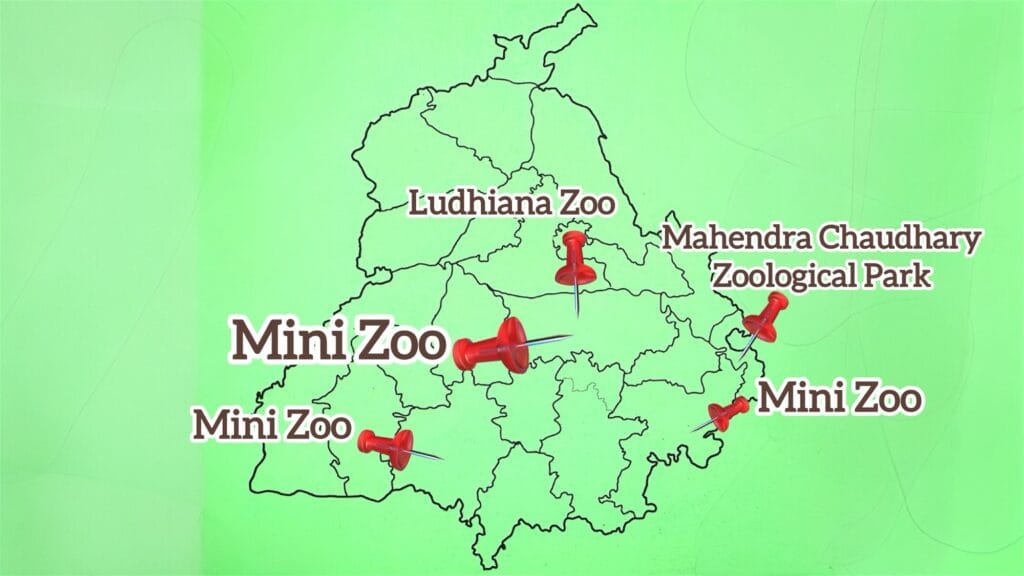
1. Mahendra Chaudhary Zoological Park, or Chatt Bir Zoo:
It is a zoological park located near Zirakpur that has hundreds of different mammals, birds, and reptiles. One of the major attractions of Chatt Bir Zoo near Chandigarh is the lion safari.
2. Ludhiana Zoo (Tiger Safari):
It is located in the Ludhiana District of Punjab.
3. Mini Zoo (Deer Park, Neelon):
It is located in the Ludhiana district of Punjab.
4. Mini Zoo (Deer Park Bir Moti Bagh):
It is located in Patiala District of Punjab.
5. Mini Zoo (Deep Park Bir Talab):
It is located in the Bathinda District of Punjab.
In conclusion, Punjab’s diverse natural heritage, encompassing Wildlife Sanctuaries, Wetlands, Ramsar Sites, Conservation Reserves, Community Reserves, and Zoological Parks, plays a pivotal role in maintaining ecological balance and preserving biodiversity. These protected areas not only safeguard the state’s rich flora and fauna but also contribute significantly to environmental sustainability, tourism, and local livelihoods.
For aspirants preparing for Punjab-level competitive exams, a thorough understanding of these protected areas is essential. Questions related to their geographical distribution, ecological significance, and conservation status frequently appear in exams like PPSC, Punjab Patwari, Excise Inspector, and other government recruitment tests. Key points such as the Ramsar Sites (Harike, Kanjli, and Ropar), National Wetlands (Ranjit Sagar and Nangal), and district-wise distribution of Wildlife Sanctuaries are particularly important.
By studying these topics, candidates can enhance their knowledge of Punjab’s environmental landscape while improving their chances of success in competitive exams. Furthermore, awareness of these areas fosters a deeper appreciation for nature conservation, encouraging responsible practices that benefit both humanity and the environment.
FAQs:-
1. What are the major Wildlife Sanctuaries in Punjab?
Punjab is home to several Wildlife Sanctuaries, including Harike-e-Pattan Wildlife Sanctuary (Tarn Taran), Takni-Rehmapur Wildlife Sanctuary (Hoshiarpur), Abohar Wildlife Sanctuary (Fazilka), and multiple “Bir” sanctuaries like Bir Motibagh and Bir Gurdialpura located in Patiala.
2. Are there any National Parks in Punjab?
No, Punjab does not currently have any designated National Parks. However, the state has numerous Wildlife Sanctuaries, Wetlands, Ramsar Sites, Conservation Reserves, and Community Reserves that play a vital role in biodiversity conservation.
3. What are the Ramsar Sites in Punjab?
Punjab has three Ramsar Sites:
Harike Wetland (Tarn Taran): Known for its migratory birds and freshwater ecosystem.
Kanjli Wetland (Kapurthala): The only Ramsar Site in the Doaba region.
Ropar Wetland (Ropar): A man-made wetland recognized for its ecological significance.
4. Which wetlands in Punjab are of National Importance?
The two wetlands of National Importance in Punjab are:
Ranjit Sagar Wetland (Pathankot): Located on the Ravi River.
Nangal Wetland (Rupnagar): Forms a long artificial lake known as Nangal Lake.
5. What is the significance of Harike Wetland in Punjab?
Harike Wetland, also known as Hari-ke-Pattan, is one of the largest freshwater wetlands in Northern India. It was declared a Ramsar Site in 1990 and is famous for migratory birds traveling from Siberia. It also serves as a wildlife sanctuary and supports diverse aquatic life.
6. How many Conservation Reserves are there in Punjab?
There are four Conservation Reserves in Punjab:
Rakh Sarai Amanat Khan Conservation Reserve (Tarn Taran).
Beas River Conservation Reserve (covering the Beas River from Talwara to Harike Barrage).
Ranjit Sagar Dam Conservation Reserve (Pathankot).
Ropar Wetland Conservation Reserve (Ropar).
7. What are Community Reserves, and where are they located in Punjab?
Community Reserves are areas owned by private individuals or communities that volunteer to conserve wildlife. Punjab has three Community Reserves:
Keshopur-Chammb Community Reserve (Gurdaspur).
Lalwan Community Reserve (Hoshiarpur).
Siswan Community Reserve (S.A.S. Nagar).
8. Which Zoological Parks are located in Punjab?
Punjab has several Zoological Parks, including:
Mahendra Chaudhary Zoological Park (Chatt Bir Zoo) near Zirakpur, famous for its lion safari.
Ludhiana Zoo , which features a tiger safari.
Mini Zoos like Deer Park in Neelon (Ludhiana), Bir Moti Bagh (Patiala), and Bir Talab (Bathinda).
9. Why are Wetlands important for Punjab’s ecology?
Wetlands in Punjab play a crucial role in maintaining ecological balance. They support diverse flora and fauna, provide habitats for migratory birds, help in groundwater recharge, and contribute to flood control. Notable wetlands include Harike, Kanjli, and Ropar, which are recognized internationally under the Ramsar Convention.
10. How can knowledge of Punjab’s protected areas help in competitive exams?
Understanding Punjab’s protected areas, such as Wildlife Sanctuaries, Ramsar Sites, Wetlands, and Conservation Reserves, is essential for competitive exams like PPSC, Punjab Patwari, and Excise Inspector. Questions often focus on their geographical distribution, ecological importance, and conservation status. Key examples include the Ramsar Sites (Harike, Kanjli, Ropar) and National Wetlands (Ranjit Sagar, Nangal).
